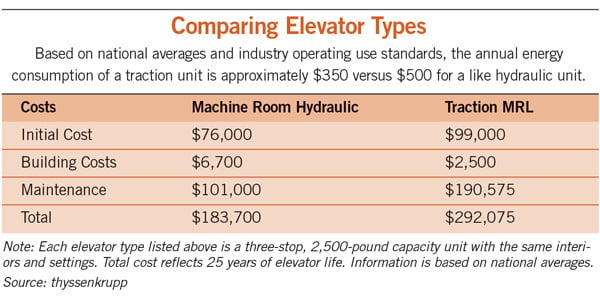The Sky's the Limit for Elevators in Today's Low- and Mid-Rise Buildings

Technological advances make the vertical journey better for tenants — and property owners.
FOR YEARS, OWNERS of low- to mid-rise buildings were forced to deploy elevators that only met some of their needs for space efficiency and lifecycle performance. It was a costly sacrifice magnified by growing urbanization challenges. Half of the world’s population now lives in cities, and urban areas are expected to grow by nearly 3 billion people by 2050. That will put significant strain on multistory buildings and the transportation systems inside them.
While the Council on Tall Buildings and Urban Habitat says the number of high-rise buildings around the world has more than tripled since 2000, mid-rise buildings represent the fastest-growing segment in the industry. These buildings, traditionally 15 stories or fewer, require modern technology solutions. This includes the elevator systems that property owners and managers rely on to safely transport tenants and visitors.
Modern Elevator Technology Steps Up
Traction elevators, which use cables and counterweights to lift the cab, are most commonly used for mid- and high-rise applications. That’s because they travel much faster and higher than hydraulic elevators, which use a pump system to push the cab through the shaft.

There are two types of traction elevators — machine room (MR) and machine room-less (MRL). Elevators with machine rooms typically include larger mechanical components for heavier duties, so they require additional space for equipment outside the shaft. This space is known as the machine room. Meanwhile, machine room-less elevators have compact equipment that can be located in the shaft. That eliminates the need for a separate machine room and gives space back to the building owner to generate more rent.
For years, traditional MRL-type mid-rise elevators were limited by speed and/or capacity restrictions due to technical drawbacks in compact shafts. Much of is related to the limitations of electric motors, but a permanent magnet AC motor now offers a more compact and powerful solution. Today, there are systems with 5,000-pound-capacity MRL elevators that can also travel up to 600 feet per minute, which was previously only attainable via very large machine-room-based traction elevator motors. New technologies are available such as polyurethane-coated belts instead of steel cables to lift the elevator cab. These belts provide longer life cycles and require smaller sheaves, which translates to smaller overhead space and shaft size in general.
Building owners also can incorporate smart technology in their elevators to move tenants and visitors more efficiently through the building while improving the rider experience. Destination dispatching technology, which aims to group passengers into elevators based on where they’re going inside a building, can improve traffic handling by up to 30 percent. However, before implementing destination dispatching technology, building developers and owners must conduct traffic studies that examine how many elevators and groups are needed. This should include the number of occupants and visitors, distribution of people by floor, typical times of arrival and departure, as well as critical traffic periods.
A Better Ride for Passengers
Beyond advances in dispatching, building owners use smart technologies both connected to and apart from the Internet to make elevators more efficient for passengers and property managers. These include personalizing the look and feel of elevator interfaces, security integrations, and even content management and control for the users.
Personalized interface options can include changing background images and designs with standard preloaded images or custom imagery. Additionally, the call allocation screen design can be changed from a single-letter indicator to a wayfinder map that helps passengers find their assigned elevator, and custom labels or names can be added to the floor buttons. Building managers can also use the technology to change the arrangement and size of the floor buttons or add logos and images to them. They can even add a customizable message to touchscreens to communicate important information to tenants.
Internet of Things (IoT) technology can help building owners use predictive analytics to manage performance and adapt to tenant needs. For example, sensors embedded into new elevator systems can capture data from elevator operations such as trips and door movements. Cloud-based computers then analyze the data to target where and when maintenance is needed. That improves mechanical reliability, leading to less elevator downtime and happier tenants.
These modern elevator systems can also eliminate noise issues. In a mid-rise building such as a hotel, hospital or luxury commercial or residential building, disruptive sounds can be a big problem. Newer technologies can bring the decibel level down to as low as 50, comparable to a refrigerator running at night or a quiet conversation in a public library. Other benefits and features include auto-rescue, in which the elevator automatically moves to the first available stop to let people out if there's a power failure.
Jon Clarine is the vice president of product management and digitalization at thyssenkrupp Elevator Americas.





